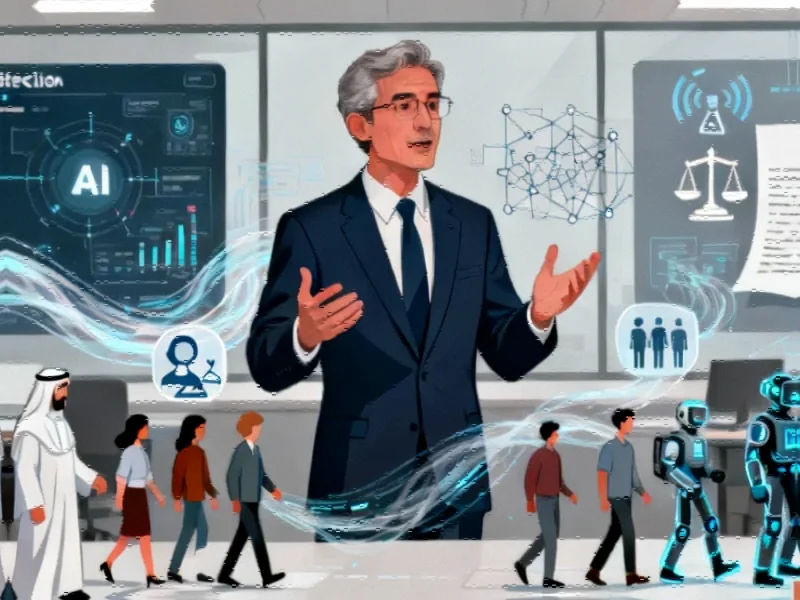The Unseen Corporate Witness
In boardrooms and break areas across the corporate landscape, employees are sharing more with artificial intelligence than most organizations realize. From strategic planning sessions to competitive analysis, AI chatbots have become digital confidants for enterprise secrets that could potentially be reconstructed into a comprehensive blueprint of your company’s future.
The recent Palisades Fire case demonstrates how seriously law enforcement now treats AI chat data. Prosecutors building their arson and murder case didn’t just rely on traditional evidence—they used the suspect’s ChatGPT logs to establish intent and premeditation. This landmark approach to digital evidence should give every enterprise leader pause about what their own AI interactions might reveal.
From Personal Diary to Corporate Record
Unlike traditional digital artifacts, AI conversations capture thought processes in motion—the hesitation before decisions, the exploration of alternatives, the testing of boundaries. Where emails and documents show finalized thinking, AI logs reveal the messy, authentic journey of how decisions are made and plans are formed.
This creates an unprecedented evidentiary trail. As AI chat logs become critical evidence in criminal investigations, corporations must consider how the same principles apply to corporate litigation, regulatory inquiries, and competitive intelligence gathering.
The Security Paradox: Control Versus Visibility
Many security teams have responded to AI risks with blanket prohibitions, creating what I call the “Security Framework of No.” This approach mirrors outdated IT security models that failed to account for human behavior and technological inevitability.
The reality is that blocking AI tools doesn’t stop their use—it merely drives activity underground. Employees seeking productivity gains will find workarounds, whether through personal accounts, alternative browsers, or unmonitored devices. The result isn’t increased security but decreased visibility into how AI is actually being used across the organization.
This security challenge parallels broader navigations of global headwinds that today’s enterprises face across multiple fronts.
Building Guardrails, Not Barriers
Progressive organizations are shifting from prohibition to guided enablement. The emerging best practice isn’t “if” but “how” AI should be used safely. This requires a fundamental rethinking of security governance that acknowledges several key realities:
- AI is already embedded across platforms employees use daily
- Blocking tools only create the illusion of control
- Security through obscurity creates unmanaged risk
- Education and awareness outperform prohibition
This approach aligns with how business leadership is strengthening their organizational capabilities across technology domains.
The Distributed Security Model
Traditional centralized security struggles to keep pace with AI’s distributed nature. A more effective approach embeds security guidance within business units, creating a network of observant, educated professionals who can provide real-time coaching.
Imagine security professionals who don’t just say “no” but can explain: “That approach risks exposing client data. Here’s a safer alternative that achieves the same outcome.” This transforms security from obstacle to enabler while maintaining protection.
These security considerations are part of larger service creation trends reshaping how enterprises approach technology implementation.
Transparency in an Opaque Ecosystem
AI companies themselves operate with significant discretion about their monitoring and reporting practices. While they publicly highlight efforts against foreign threat actors, their domestic monitoring capabilities—and cooperation with law enforcement—receive less attention.
OpenAI’s policy of disclosing user data to prevent “emergency involving danger of death or serious physical injury” creates a broad mandate that could extend to corporate contexts depending on interpretation. Organizations need to understand that their AI interactions aren’t necessarily private, even when using enterprise accounts.
This evolving landscape requires careful navigational strategies similar to those employed in financial governance.
Practical Steps Forward
Moving from awareness to action requires concrete measures that balance innovation with protection:
- Establish clear AI usage policies that define acceptable versus restricted use cases
- Implement technical controls that prevent sharing of sensitive data without blocking productive use
- Create AI literacy programs that help employees understand both capabilities and risks
- Develop incident response plans specifically for AI-related data exposures
- Regularly audit AI usage patterns to identify emerging risks and opportunities
These security considerations intersect with broader surveillance evolution trends affecting multiple technology domains.
The Competitive Imperative
Ultimately, the organizations that will thrive in the AI era aren’t those that avoid the technology, but those that learn to harness it safely. The baseline security posture must shift from “no” to “yes, with appropriate guardrails.”
This requires acknowledging that nobody fully understands AI’s implications yet—and that admitting this uncertainty is where intelligent leadership begins. The goal isn’t to stop the dance, but to ensure it happens safely, with awareness of both the music and the potential missteps.
As AI continues to reshape the corporate landscape, the organizations that build cultures of responsible experimentation—rather than fearful avoidance—will define the next generation of industry leadership. The corporate confessional is open; the question is whether your organization understands what’s being shared and how it might be used.
This article aggregates information from publicly available sources. All trademarks and copyrights belong to their respective owners.
Note: Featured image is for illustrative purposes only and does not represent any specific product, service, or entity mentioned in this article.



